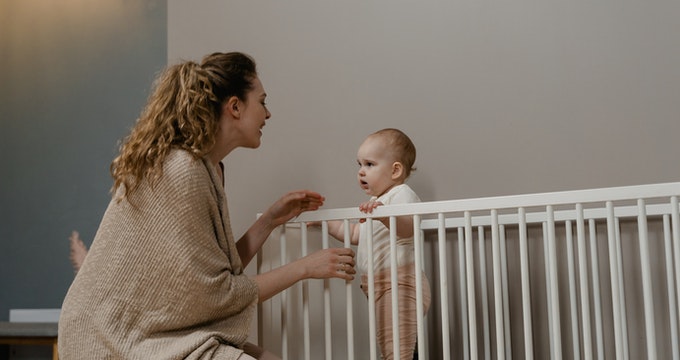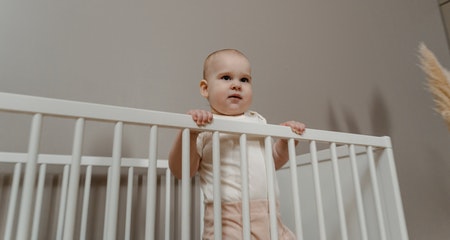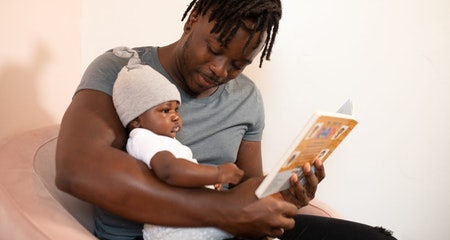If your baby standing in the crib, they are most likely not sleeping. However, babies and toddlers of all ages will occasionally stand up in their cribs and cry. This article will teach you when standing in the crib begins and how to deal with it.
Is standing in the crib something babies do on purpose?
Well, yes sometimes. And, at times, it is most likely instinctual.
Standing in the Crib is Normal

During the 8-month sleep regression, babies typically begin standing in their cribs. In general, this is the stage at which babies become much more mobile. Some babies may learn this new skill as early as 6 to 7 months of age, while others may not learn until 9 to 10 months. Every baby develops at its own pace.
Babies frequently “practice” in their sleep when learning a new skill. It’s something they can’t control. And it can be exhausting when they’re first learning to stand, which is around 8 to 9 months old. They may be crying hard in their crib and unable to return to sleep. This can cause their sleep to be disrupted to the point where they wake up frequently during the night. They may also stop napping or take short baby time.
Read: Cribs for tall babies
Why Do Babies Start Standing in The Crib?

Standing is a significant developmental milestone for your child. Can you imagine being upright after spending most of your life on your back or hands and knees? The entire world appears to have changed, isn’t it? It’s pretty incredible for them, and they want to do it all the time, which means both during the day and night.
Kids do go through a stage where they can pull themselves up onto their crib rail and lock their knees, but they don’t know how to come down. Imagine it must be frightening for them. And when they are helped with laying down again, they think to themselves, “Hey, I want to practice standing again. That was fun.”
When your little one is bigger, and the new skill is no longer new, he or she may stand in the crib out of frustration or because their schedule needs to be changed.
However, there are many reasons why a child isn’t sleeping and standing in the crib. So depending on the skills, you’ll know whether standing is the cause or just a way to avoid sleeping. You need to approach each one differently.
How Do You Get Your Baby to Sleep When They Keep Standing Up?

This is something that every child will go through. It’s one of those “this, too, shall pass” phases. But there are steps that and my husband took to avoid sleep regression and got our little one to sleep better while he kept standing in the crib.
Most babies will quickly figure out how to get back to sleep. My two boys picked up on this within a few weeks of learning to stand. If they aren’t crying, try not to pay too much attention to the baby standing in the crib.
However, because they can fall and hit their heads, it’s a good idea to have a plan in place. If your child resists your efforts to get them down, you must come up with new sleep patterns to get your kid to sit down.
Hence, I present you with 13 sleep tips that we applied for our baby, and you can try with your kid too:
- If your baby started standing in the crib and grip the crib bars while sitting, you can take a step back and leave for a few moments before trying again.
- Make an effort to have your baby practice falling and stay asleep, as well as getting back up during non-sleep times. Make your baby, for example, sitting on a couch or sofa. Then, on the ground, place a toy next to them and help them bend their knees to reach the toy. It called squats for toddlers, which will quickly become automatic.

- Even if they are getting better, they may find awake time to be exciting in the crib and practice the standing skills. What you can do is, put them down a little earlier for short naps for a while to allow them to practice. Then, soothe them and encourage them to sleep closer to the time you expect them to.
- If they continue to resist, step away from them for a while. Resistance would only magnify the situation. With some patience, your child will gradually tire and understand why they need to lie down.

- You could also try teaching your child to lie down on their own in the morning. This tactics will help your kid to become familiar with the act so that they instantly try to lie down as you taught them if they manage to stand up.
- You can encourage your child to lie down by singing to them while teaching them to do so. Singing them “Ring Around the Rosie…” is a good way to accomplish this. Hold your child’s hand as you sing, and when the line “… and we all fall down” comes, easily sit them down on their bottom. Not only will your child enjoy the activity, but it will also encourage them to try it on their own. It may take a couple of weeks for you to see the results. Games can also be used as an alternative.

- You can sing a lullaby to your little one or speak to them softly during their sleep or nap time to help them relax and feel sleepy. You can soothe them to sleep by stroking their cheeks or back after they have fallen asleep. Of course, you must stop doing this before they fall asleep, as it will teach them how to sleep independently.
- You can also try to shorten their nap times and get them moving by allowing your baby standing in crib and play as they please. When it’s time for bed, your child will fall and stay asleep quickly and deeply. Swimming for 20 to 30 minutes in the evenings has helped my baby fall asleep much more easily and reduces the likelihood of his night wakings.

- You can also buy a sleep sack or sleeping bag, which will keep them from moving around too much. It can also keep them in place because their legs can’t move much when they’re in a sleep sack.
- Make changes to your child’s nursery to make it more conducive to nap times and sleeping. When your child is between the ages of 6 months and a year, their senses are at their peak, and anything can pique their interest. Your child will be unable to resist sleeping if you create an environment that confuses their senses and makes them sleepy. You can adjust the temperature of the room, as well as the curtains and the large lights. And, most importantly, make sure you are using Non Toxic baby crib and mattress in the nursery to insure the perfect environment for your little one to sleep.

- If you sleep in the same room as your child, make sure you have everything you need in your room before his/her bedtime. And try not to enter suddenly in the room while s/he is trying to sleep. You can also purchase a music box or a white noise machine. A soothing melody or humming can lull your child to sleep (as mentioned earlier).
- If you are breastfeeding your baby at night, allow them to co-sleep in your bed with you while they nurse. Babies who co-sleep with their mothers and nurse at the same time sleep longer. It also reduces your child’s chances of sticking to the rails on his own. You can monitor them and ensure they get a good night’s sleep while they are in bed with you.
- Finally, once you are confident that your baby knows how to get down on their own, you can use sleep training to break any bad habits. However, your strategy may need to be tweaked slightly. I usually recommend that parents lay their babies down on a regular basis rather than constantly. Put them down every 8-10 minutes, for example, to give them time to figure it out on their own.
Sleep Training Advice for Babies

Sleep training is a manner of teaching your baby to fall asleep on their own and to self-soothe. When your baby learns to fall asleep on their own, they can also learn to fall back and staying asleep on their own during the night wakings. We all wake up between sleep cycles, but your baby must understand how to enter another sleep cycle. Keep in mind that sleep training does not always imply night-weaning. Depending on your baby’s age, though.
The best age for sleep training is usually around 4 to 6 months old. However, it is never too late or early to begin sleep training a baby.
These are 5 primary sleep training techniques, though each has many variations:
- The Fading Method
- The Pick-Up-Put-Down Method
- The Chair Method
- Ferber Method
- Cry-It-Out Method
The Fading Method (FIO)
The Fading Method is a gentle, no-tears/no-cry (or very little cry) sleep coaching method in which you “fade it out” (FIO). The Fading method allows you to continue assisting your baby in falling asleep (by rocking or feeding to sleep, for instance). However, as time passes, you do less and less work to put your baby to sleep while your baby does more and more.
For example, if your baby standing in the crib, you normally rock your baby to sleep. You may reduce the amount of time you rock each night until you are only rocking for a few minutes as part of the bedtime routine. In some cases, this method needs patience from many parents. However, it’s ideal for families who want to reduce crying as much as possible.
Bedtime fading can also refer to any sleep training strategy that gradually reduces a parent’s presence in the baby’s room when putting her to sleep.
Is your child wailing for long periods of time before falling asleep? Her/his body may or may not be ready for sleep at the time you specify. You can use the bedtime fading method to change her circadian rhythm and get bedtime to where you want it. This is how it is done:
- Take note of your baby’s sleep cues, such as eye rubbing, yawning, turning away from lights or sound, and fussiness.
- Put your baby to bed when s/he appears tired.
- If she doesn’t fall asleep quickly, take her out of the crib for a set amount of time (say, half an hour) and try again.
- After a few nights of putting her down at that point, move bedtime forward 15 minutes and repeat the cycle with this new bedtime.
- And gradually keep advancing your bedtime by 15 minutes at a time until you reach your desired bedtime.
The Pick-Up-Put-Down Method (PUPD)

Another gentle sleep training method is the Pick-Up-Put-Down Method. The PUPD method works exactly as it sounds. Suppose, your baby is fussing or crying hard in the crib or bassinet, you scoop them up and comfort them until they are quiet and tired. Then you place them back in their crib to sleep, repeating the process until your baby falls asleep.
NB: However, Pick-Up-Put-Down is a method that depends on your baby’s patience. Unfortunately, it will not work for every baby. Picking up and putting down some babies is overstimulating. They can gradually become frustrated and fired up instead of relaxed.
The Chair Method
This method may be more effective for older babies and may be more comfortable for you (and your baby) than screaming it out. Sit down next to your baby’s crib and wait for her to fall asleep without picking her up. Then, each night, move the chair further away to the door until you’re right next to it.
Your baby should be able to fall asleep without your presence at that point.
NB: While this technique may be appropriate for some families, be aware that it may result in more tears for some babies. While your baby settles down with you in the room, she may be frightened and upset when she wakes up, and you are no longer present.
Ferber Method
Are you opposed to allowing your baby to cry without some form of attention and comfort? Try the Ferber method, a type of “graduated extinction” or “check-and-console” that implies letting your baby cry for a set amount of time before checking on her. Each timed interval of crying lasts a few minutes longer than the previous one until she falls asleep.
Throughout several nights, you will gradually lengthen these intervals. And lowering your existence in the baby’s room to allow your baby to do more of the work of settling down. Pretty shortly, there will be no need for these pleasure check-ins since your baby will have learned to self-soothe.
Cry It Out (CIO)

The cry it out method of sleep training, also known as the “extinction” method, entails putting your kids to bed and allowing her to cry until she falls asleep without your comfort or assistance.
That means you won’t go back into her room until you’ve ensured she’s asleep with a full tummy and in a safe sleep environment. Unless it’s time for her to wake up in the morning, or she needs to be fed.
Also read: How to Prevent Toddler or Baby from Climbing out of Crib?
While it may appear harsh, CIO is harsher on you than on your child. With consistency (the key!), your baby should be able to fall asleep on her own in three to four nights.
Conclusion
Last but not least, I encourage parents to take one day at a time and listen to their child’s cues. Because each baby is unique, the sleep patterns and steps may need to be repeated. The time it takes will also vary depending on your baby. So be patient and understand that this is difficult for your baby; they are tired, frustrated, and trying to learn how to turn it off. So practice, practice, and practice!
Standing in the crib, as most sleep regressions and phases come to an end. To end with, just follow the methods I’ve mentioned above and put in a little more effort upfront. In the end, you’ll all be sleeping more in a fortnight!
Related: